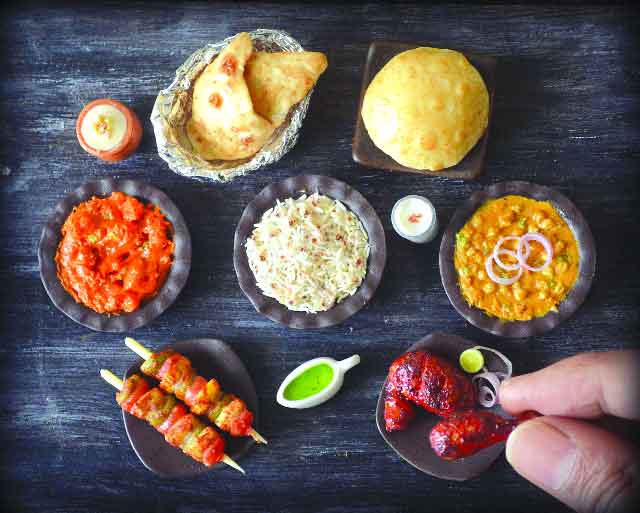The food story has progressed and gone beyond the simple chicken tikkas and Chinese to a more evolved understanding and in-depth exploration of concepts like sustainable dining and stories behind each dish. By Team Viva
Indians have expanded their culinary boundaries in all directions. Taste and preferences changed along the way and the audacity of experiments rose. With growing urbanisation and millennials staying away from their families, dining at restaurants and cafes that reminded Indian foodies of a meal rustled up at home became the preferred choice. Decline in daily cooking at home due to changing social dynamics and attitude towards cooking has also brought about this transformation and thus powered this longing for ‘ghar ka khaana.’ However, these are just some trends that have created a new normal.
Reaching out to over 150 experts — chefs, thought leaders and food influencers across major cities — a report by Godrej provides on-ground insights on food trends from the four directions — north (Delhi), south (Chennai and Bengaluru), east (Kolkata) and west (Mumbai). Data has been collected from various celebrity chefs, home chefs, professional chefs, food bloggers, health professionals, media professionals, mixologists, nutritionists, restaurateurs, sommeliers, food producers, and many more, who shared deep insights about their respective areas of expertise.
North
Think of the north India and invariably Delhi crosses the mind first. The place is synonymous with butter chicken. This was the been the case, at least until a decade ago. But the past few years have seen a huge shift in the dining habits of north Indians. Regional cuisines have flourished. Punjabi, Sindhi, Khatri, Bihari, Muslim, Kayastha, Baniya, Bengali, North Eastern and even South Indian flavours are being explored in the metros and savoured in smaller towns.
While there is an entire new food universe that has mushroomed which includes concept kitchens, casual diners, clubs, pubs, breweries — you name it and they have it. However, as a region, the north continues to patronise dining out at restaurants and street food outlets but the home chef-driven pop-up concept never took off here.
Even though Delhi remains the epicentre and trendsetter when it comes to the food industry, but, the past few years have also seen smaller cities in the north discovering their own culinary identities. Lucknow is happy to pay a premium for Baghare baigan now, while Chandigarh continues to celebrate Sarson ka saag. Dehradun and Nainital have woken up to the beauty of Jakhiya aloo and Bhang ki chutney and Bihar’s Litti-Choka is setting tongues on fire. Delhi meanwhile is happy to indulge everyone — whatever their preference maybe.
Global warming and pollution have been issues in focus, and this has led to a big shift in focus on sustainability, demand for organic food and back-to-roots dining. Urban farmers are bringing long overdue focus on clean crops and millets; organic grains, and local ingredients are being celebrated, albeit at a niche level.
South
South India comprises the culinary diversity of Kerala, Tamil Nadu, Andhra Pradesh and Karnataka. Here is a region steeped in rich culinary traditions that continues to influence the dining culture, alongside celebrating new age trends.
All across the South, there has been an inward focus and native micro-cuisines are being celebrated; from the Temple cuisine of Tamil Nadu, to the Gowda cuisine of Karnataka, from the Mapilla food of Kerala, to culinary traditions of Rayalseema in Telangana and more. Large scale movements like Karnataka spear-heading the revival of traditional millets recently or even Kerala’s jackfruit that has become synonymous with the global vegan trend, characterise the region’s food.
Dining, both in and out, have been dynamic here. Bengaluru, celebrates pan-Indian and global trends in equal measures, while adding it own innovative spins. You will find Donne Biryani on brewpub menus just as easily as you would find Nikkei-styled ceviches in Asian restaurants. Chennai, a bastion of traditional food cultures, is increasingly known for great Asian and Japanese cuisine options. Micro-brewing has taken the south, particularly Bengaluru by storm, with Hyderabad picking up pace. Across the Southern states provenance of food is being given importance, alongside a demand for both traditional and modern experiences for the diner to explore.
These experiences range from pop-ups by celebrity international chefs or home chefs championing a lesser known micro-cuisine. It includes thematic tables with story-telling; pairings with a range of beverages and even take-home chefs, pre-prepped food kits and more. Going back to roots with traditional home cooking, right down to the use of cookware particular to a dish or region is also common today.
East
As Eastern and North Eastern cuisines — be it Assamese, Bihari or Oriya — gain prominence nationwide, within the region, native cuisines are being revisited by home cooks and chefs alike, who are digging deeper into region’s culinary and cultural repertoire, breaking existing moulds, challenging stereotypes and presenting a fresh, more nuanced perspective on these cuisines.
Local ingredients and indigenous produce are coming into the limelight not just in the home-dining space but also in the restaurant kitchen. For instance, in Bengal the mounting interest in reviving and espousing the region’s mind-boggling indigenous rice diversity, has encouraged Kolkata restaurants to put a Tulaipanji or a Dudheswar on the menu, instead of the ubiquitous Basmati.
At the same time diners have also grown more inquisitive about the what, how, wherefrom and why of the food they eat. There’s also a growing proclivity for experiential dining with a focus on story-telling. The story behind the food — a slice of history, an anecdote or even a few words on the source of ingredients — is as important as the dish itself. The growing mindfulness around food has also encouraged the spirit of revivalism. Overall it seems that the key to move forward is to look back and dig deep.
West
How far we’ve come! We’ve moved on from Italian, Chinese and coastal cuisine — to Neapolitan, Cantonese, and seasonal sustainable seafood. And this not only in the busiest urban centres of western India, but also in Bhavnagar and in Raigarh, in Udaipur and in Mangalore.
Mumbai, as the commercial and culinary capital of the region, has been long known for its urbane dining scene. It’s a city that knows how to eat well, on and off the streets, at home and outside, in front of the television, at solo tables, at sit-down multi-course dinners, and at decadent half-day-long brunches. In recent years, we enjoy celebrity chef pop ups, we love being fed by talented regional home cooks, we enjoy fancy catering events that offer us flavours from across the globe. And we ask for and have all of this, without taking ourselves too seriously.
But delightful dining can be found beyond the Millenium city and all over the region. Ahmedabad has restaurants and traditional food festivals that are destinations unto themselves; Goa’s restaurant scene has never been more thrilling; Nashik is where we make some of our best wines; Jaipur recently had a chocolate festival.
And so it follows, that, in the last decade, we’re asking for more from our food industry, and we’re getting it. As purveyors and diners, we have access, talent, curiosity and interest. We have knowledge and pride in our regionality and in the quality of our ingredients, as well where they (and we) come from. Mumbai has Latin American and Ethiopian restaurants now, yes, but indeed, we also have Sindhi eateries and food festivals serving Assamese silkworm pupae right alongside our burgeoning craft beer and gin scene.
In the last decade, we’ve gotten better at understanding food, and we’re continuing to get better at understanding ourselves through what we eat.


























